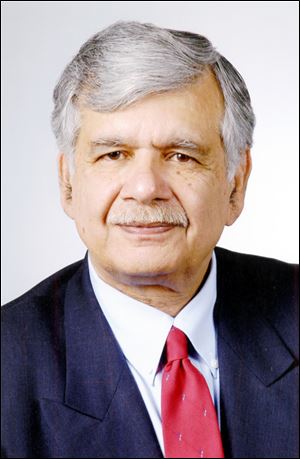
COMMENTARY
India, Pakistan need to face their past to resolve the present
10/28/2013
Hussain
It has been 66 years since India was cleaved by the British into a majority Hindu India and a predominantly Muslim Pakistan. The story of that awful split has been told and retold in history books, novels, and movies.
You would think that with the passage of time, India and Pakistan would reconcile their differences and embrace a common history and shared traditions as two neighbors.
I recently received a chain email with photographs of the partition. Originally published in Look magazine, these gut-wrenching photos evoke emotions that are as raw now as they were when the drama of partition unfolded.
The passage of time has not made them irrelevant. As a 9-year old boy growing up in the predominantly Muslim city of Peshawar, I was witness to some of the atrocities that the pictures portray.
The picture of devastation is unbelievable: scattered bodies of dead people and bloated carcasses of dead animals, caravans of thousands of people inching their way toward the safety of a new country they had not seen, an emaciated infant suckling at the breast of a dying mother, stray dogs gorging on human flesh.
It is important to keep telling the story of partition until Hindus, Muslims, and Sikhs accept their role in one of the greatest tragedies that faced the human race. One million people died and 10 million more were made homeless.
Yet people in India and Pakistan have their own interpretation of events. These self-serving narratives are at odds with what the historians, fiction writers, and moviemakers have recorded.
Wahga is the only land crossing on the 1,800-mile border of India and Pakistan. The place endured much violence as multitudes struggled to get to the crossing from both directions.
In a short story by Saadat Hasan Manto, both countries decide to repatriate patients in mental asylums. One patient is agitated about why he is being sent to an unknown place. The next day he is found dead, sprawled across the no-man’s-land.
In 2006, I crossed Wahga on my way to Amritsar, India, where I was going to teach at the Government Medical College. The weight of history still hung heavy on me when I was invited to speak to the local Rotary Club.
I suggested it was time that all of us from the Indian subcontinent come clean and put the ghosts of partition to rest. Perhaps a monument should be erected on the no-man’s-land — where Mr. Manto’s fictional character had died — showing a Muslim, a Hindu, and a Sikh with their heads bowed in shame and an inscription: We are ashamed of what we did to each other.
There were no takers at Rotary. And there weren’t any in Pakistan and in the Indo-Pakistani diaspora. Most of us from the subcontinent are still defined by arrogant self-righteousness about the partition.
India and Pakistan have been on a war footing against each other for most of their existence. The introduction of nuclear weapons has heightened the tension.
Yet there is much more that unites and defines people on both sides of Wahga than divides them. Shared languages, cuisine, arts, literature, and music are much more uniting than the unresolved geopolitical issue of Kashmir.
When the Indian and Pakistani prime ministers met at the United Nations General Assembly a few weeks ago, I was optimistic something substantial would emerge to resolve their outstanding differences.
But the meeting between Pakistan’s Nawaz Sharif and India’s Manmohan Singh was anticlimactic. They agreed to continue contacts between senior military officers to reduce tensions along the “line of control”.
Apparently the past understanding between Mr. Sharif and his then-Indian counterpart, Atal Bihari Vajpayee, in the late 1990s is no longer a reference point. At that time, it was widely understood that the two leaders had agreed on a formula to resolve the thorny issue of Kashmir.
Any possibility of rapprochement, however, was scuttled when Gen. Pervez Musharraf staged a coup against the civilian government of Mr. Sharif.
Reconciliation between warring factions starts with confidence-building measures. The biggest, most painful one is for Indian Hindus and Sikhs and Pakistani Muslims to come clean about their ugly past.
If they need a reminder, they could look at the pictures.
Dr. S. Amjad Hussain is a retired Toledo surgeon whose column appears every other week in The Blade.
Contact him at: aghaji@bex.net